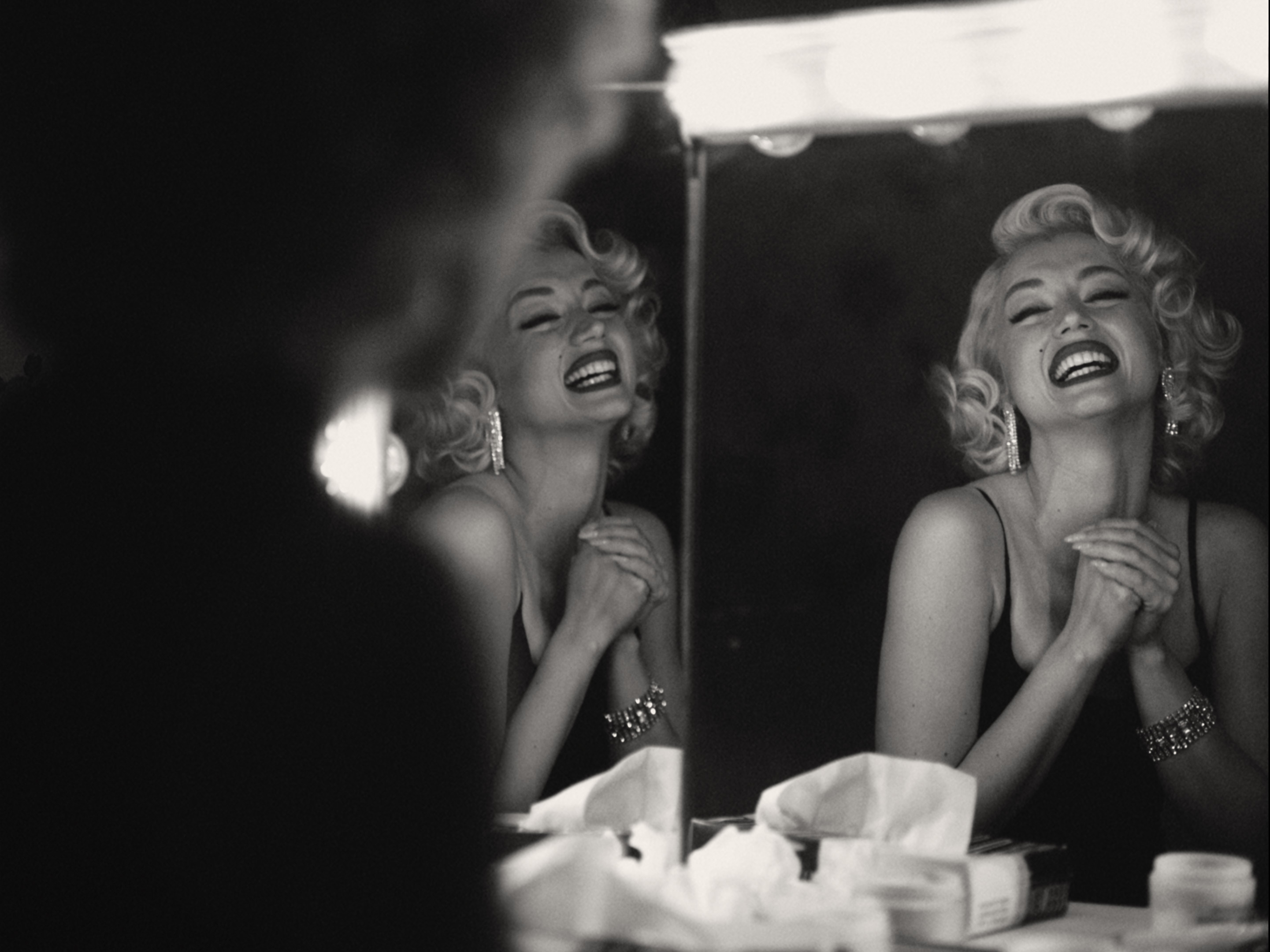
In one of the last interviews before her death, Marilyn Monroe talked at length about the experience of being famous. People “want to see if you're real,” she said about fans approaching her. “Their faces light up. … You've changed their whole day.”
But the 36-year-old had also seen the emotionally punishing side of fame by then. The public thinks they have “some kind of privilege to walk up to you and say anything to you … of any kind of nature,” she said. “You’re always running into people's unconscious.”
This was an astute description of celebrity from the side of the famous: a perpetual run-in with people’s fantasies. She understood that everyone makes up their own Monroe. When she was alive, she became an icon of 1950s white femininity by disrupting the boundary between sexy girlfriend and virginal wife. And since her death in 1962, she’s become a symbol of every possible thematic configuration of gender and celebrity.
There have been biographies, memoirs, academic studies, and movies with a multitude of perspectives, including whatever Norman Mailer was doing in his 1973 psychobiography of her, feminist reckonings in the ’80s with the way she had been blamed for promoting regressive roles, and sympathetic ’90s TV movies emphasizing the split between the young Norma Jeane and the grown-up Marilyn.
She feels like the most overstudied woman celebrity in history. Now, Netflix’s Blonde has arrived, preceded by controversies about the film’s graphic sexual violence and talking CGI fetuses. In an interview with Vulture, director Andrew Dominik described his film as being daringly true to the darkness of Monroe’s own life.
“I think if I’m given the choice, I’d rather go and see the NC-17 version of the Marilyn Monroe story,” he explained. “Because we know that her life was on the edge, clearly, from the way it ended. Do you want to see the warts-and-all version or do you want to see that sanitized version?” In another interview, he emphasized that “there’s something in it to offend everyone.”
Tastefulness in cinema is often gendered; think about the persistent imbalance of male versus female nudity, to mention just one thing. So disrupting decorum could be a way to reckon with the forms used to tell women’s stories and explode biopic conventions.
The ultimately dull Blonde is not up to the task. It attempts to be comprehensive, following the chronology of Monroe’s life in vignettes, thematically connected by the ways she was dehumanized. And there’s a watchable quality to the conceit at first.
But as it stretches into three hours, one starts to wonder: Why another Monroe project? And what does Blonde want from her? The answer seems to be that she’s a canvas for streaming-era edginess.

When a life story or myth is as sprawling as Monroe’s, the easiest way to find a new angle is to zero in on a specific period of time or new source material. My Week With Marilyn (2011) charmingly chronicled a seven-day period during the filming of The Prince and the Showgirl to construct a finely tuned portrait of her experiences as an actor and a woman. More recently, miniseries like 2015’s The Secret Life of Marilyn Monroe have turned to books that uncovered new information about her mother, Gladys, giving more insight into her role in Monroe’s life.
Dominik wrote Blonde drawing on Joyce Carol Oates’s 2000 doorstopper of a novel. Before she became a social media reactionary tweeting that young white men aren’t getting published enough, Oates had a knack for writing emotionally evocative books about family dynamics and young women’s feelings — like the Oprah-approved We Were the Mulvaneys (1996).
Her attempts to expand into the dark side of Americana with fictionalized novels inspired by, say, Chappaquiddick and JonBenét Ramsey have been less successful. They don’t add any real perspective to the real-life stories. Rather than commenting on their cultural metaphors, these books seemed to drown in the media clichés that made these stories famous.
Oates’s fictionalized account of Monroe is also an attempt to contextualize the fantasies attached to her. But it actually trades in something we already knew about stardom — Monroe is a symptom of the pitfalls of celebrity — and tries to shock us with the idea that even the most luminous star is subject to physical mundanities like menstruation. Dominik’s film follows suit.
Like the novel, the movie never decides whether it wants to be a study of Monroe the icon, the actor, or the woman. The film starts with Norma Jeane as a little girl (Lily Fisher) being raised by a mother with schizophrenia, then a little-understood mental illness.
Gladys (Julianne Nicholson) pines for an imaginary husband and becomes, alongside Norma Jeane’s absent father, one of the many figures who haunt Monroe, figuring in her life even after she is committed to a long-term hospital stay.
The film’s formal techniques are promising, including its black-and-white starkness, a tense minimalist soundtrack, and the way it avoids linearity, jumping across the myth and the woman in impressionistic scenes. Through its camera angles — scenes are often shot from Monroe’s perspective — the movie succeeds in making the viewer inhabit the young girl’s feelings, evoking the oppressiveness of abuse as Gladys strikes and even tries to drown her.
We meet Ana de Armas’s adult Monroe through meticulous re-creations of her most famous photography sessions and movie auditions, from her pinup era to her starring role as the tormented Ella in Don’t Bother to Knock (1952). De Armas looks exactly like Monroe and makes the latter's cooing voice and doe-eyed gaze her own, as convincingly as Michelle Williams did in My Week With Marilyn.
The movie’s most coherent, if obvious, theme is about how all the men in her life used her. We see — and feel — the pain and horror as she’s raped by a studio head who offers her opportunities in a movie. In a throuple dalliance with Charlie Chaplin Jr. (Xavier Samuel) and his actor friend, and subsequent marriages to characters referred to as The Ex-Athlete (Bobby Cannavale) and The Playwright (Adrien Brody), they are all there to ultimately betray her.
But the themes don’t receive the necessary support from the dialogue, which can be preachy (like when she calls herself a “piece of meat”) or makes characters into second rate cultural commentators (her name is “so phony, like you invented yourself,” Chaplin tells her). Monroe as a self-invention icon? Groundbreaking.

There’s plenty of detail about the many injustices she sustained. The Ex-Athlete (representing Joe DiMaggio) and The Playwright (Arthur Miller) both want her to play a demure wife and mom. DiMaggio beats her, while Miller condescends to her and, in some of the most realistic dialogue, subtly conscripts her into his ideas of a woman as someone who would never be cruel to a man.
That subtlety is rare, though. Blonde seems to take pride in its unflinching gaze, assuming an aggressive truth-telling stance. For example, we see doctors penetrate her body for an abortion. Secret Service agents forcibly ferry Monroe to meet The President (Caspar Phillipson, in JFK mode), who in turn pushes her to perform fellatio on him. Men from her entourage inject her with drugs, and she unravels on the set of Something’s Got to Give, the movie she was fired from before her death.
Often the movie feels like the director just discovered an article on the violent power of the cinematic male gaze and wants to flip porny sexualization into body horror. Blonde stretches into the ridiculous — and creepily conservative — when a fetus appears onscreen and we hear its voice. Screen-sized and pulsating in placental juice, it haunts Monroe. But the bizarre footage just becomes another excuse for drearily unoriginal dialogue between Monroe and the phantom, which accuses her of killing it.
For all the tabloids that built up a “mystery” around Monroe’s 1962 death from barbiturates, it’s not as if she didn’t write an autobiography or partake in insightful interviews about her dehumanizing relationship with Hollywood. Many people have dissected her legacy, writing about her savvy understanding of the post–studio system movie industry.
None of this is to be found in the movie. By the end of the story, Monroe is unraveling, reduced to the same narratives found in several other dramatizations of her life: a little girl pining for her daddy and her stuffed toy tiger.
But the themes are so banal that this trenchant approach doesn’t feel like it’s in service of anything.
These scenes are poignant and affecting, especially thanks to de Armas’s coherent performance. And there is something daring about the way the movie slaps audiences with the feelings of feminine trauma. But the themes are so banal that this trenchant approach doesn’t feel like it’s in service of anything.
“If it had come out a few years ago, it would have come out right when #MeToo hit and it would have been an expression of all that stuff,” Dominik said about the timing having to be right for the complexity of his vision. “We’re in a time now, I think, where people are really uncertain about where any lines are,” he said, seeming to allude to how representation has now advanced from being subject to moralizing about consent or “positive” images.
Pat emotionality — like sentimentalizing fetuses — can be boring. And so can aimless narratives. Pablo Larraín’s 2021 Princess Diana movie, Spencer, an impressionistic fan fiction–y take on a miserable royal Christmas, felt similarly random and likewise fascinated with vomit and the workings of a famous woman’s body and motherhood.
Of course, you don’t need to look up the past to find these themes. Women who disrupt America’s obsession with the innocence of white girlhood continue to be endlessly exploited and analyzed through pathologizing microscopes. And whatever new insight there is to gain about these issues probably won’t be found in a movie that thinks there’s something deep about a scene juxtaposing JFK ejaculating with footage of an explosion.
To quote Monroe, that feels like the director showing us his unconscious. ●
